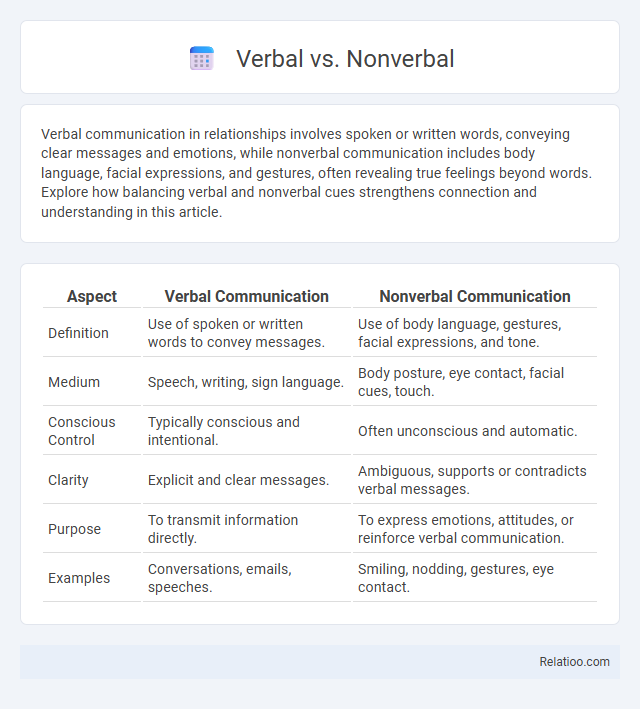Verbal communication in relationships involves spoken or written words, conveying clear messages and emotions, while nonverbal communication includes body language, facial expressions, and gestures, often revealing true feelings beyond words. Explore how balancing verbal and nonverbal cues strengthens connection and understanding in this article.
Table of Comparison
| Aspect | Verbal Communication | Nonverbal Communication |
|---|---|---|
| Definition | Use of spoken or written words to convey messages. | Use of body language, gestures, facial expressions, and tone. |
| Medium | Speech, writing, sign language. | Body posture, eye contact, facial cues, touch. |
| Conscious Control | Typically conscious and intentional. | Often unconscious and automatic. |
| Clarity | Explicit and clear messages. | Ambiguous, supports or contradicts verbal messages. |
| Purpose | To transmit information directly. | To express emotions, attitudes, or reinforce verbal communication. |
| Examples | Conversations, emails, speeches. | Smiling, nodding, gestures, eye contact. |
Understanding Verbal and Nonverbal Communication
Verbal communication involves the use of words to convey messages, emphasizing clarity, tone, and vocabulary to enhance understanding. Nonverbal communication includes body language, facial expressions, and gestures that often reveal emotions and intentions beyond spoken words. Your ability to interpret both verbal and nonverbal signals enables more effective interactions and deeper comprehension of others' messages.
Key Differences Between Verbal and Nonverbal Cues
Verbal cues rely on spoken or written language to convey meaning, while nonverbal cues use body language, facial expressions, gestures, and tone of voice. Your ability to interpret these signals influences the clarity and effectiveness of communication, as verbal cues provide explicit information, whereas nonverbal cues often reveal emotions and attitudes. Summoning differs by specifically involving requests for attention or presence, usually through deliberate verbal or nonverbal signals.
The Role of Language in Verbal Communication
Verbal communication relies heavily on language as the primary vehicle for conveying meaning, allowing you to express complex ideas, emotions, and intentions clearly through spoken or written words. The structured syntax and vocabulary of language enable precise transmission and understanding between individuals, ensuring effective interaction and reducing ambiguity. In contrast, nonverbal communication depends on body language, tone, and facial expressions, while summoning involves invoking presence or attention, emphasizing that the role of language remains central to verbal exchanges.
Types of Nonverbal Communication Signals
Nonverbal communication signals encompass kinesics (body movements and gestures), proxemics (use of personal space), haptics (touch), and oculesics (eye behavior). These types convey emotions and intentions without spoken words, influencing how your message is perceived. Understanding these signals enhances your ability to interpret and respond to others effectively in various settings.
Cultural Influences on Verbal and Nonverbal Interaction
Cultural influences significantly shape verbal communication through language, dialects, and speech patterns, affecting meaning and interpretation across different societies. Nonverbal interaction, including gestures, facial expressions, and body language, varies widely among cultures, making context essential for accurate understanding. Summoning rituals, often embedded in cultural traditions, blend verbal commands with specific nonverbal cues, highlighting the importance of cultural context in effective communication.
Importance of Nonverbal Communication in Relationships
Nonverbal communication plays a crucial role in relationships by conveying emotions and intentions that words often cannot fully express, such as through facial expressions, body language, and eye contact. It helps build trust and understanding by providing cues that reinforce or contradict verbal messages, making interactions more authentic and emotionally resonant. Recognizing and interpreting these nonverbal signals enhances connection and reduces misunderstandings, which is essential for emotional intimacy and effective communication in both personal and professional relationships.
Common Misinterpretations in Nonverbal Messaging
Nonverbal messaging is frequently misinterpreted due to cultural differences, ambiguous body language, and varied personal experiences that influence perception. Gestures like eye contact, posture, or facial expressions may convey different meanings across cultures, causing misunderstandings in communication. Accurate interpretation requires awareness of context, as nonverbal cues can either contradict or reinforce verbal messages, leading to confusion in summoning or other verbal interactions.
Verbal and Nonverbal Communication in the Workplace
Verbal communication in the workplace involves the clear and effective use of spoken words, which helps convey instructions, share ideas, and resolve conflicts efficiently. Nonverbal communication, including body language, facial expressions, and tone of voice, plays a crucial role in reinforcing or contradicting verbal messages, influencing workplace relationships and team dynamics. Your ability to master both verbal and nonverbal cues enhances collaboration, boosts productivity, and fosters a positive professional environment.
Enhancing Communication Skills: Balancing Verbal and Nonverbal
Mastering communication requires a strategic balance between verbal and nonverbal techniques, as verbal communication conveys explicit messages while nonverbal cues reveal emotions and reinforce intent. Enhancing communication skills involves interpreting body language, facial expressions, and tone alongside clear articulation and concise language use, increasing overall message clarity. Effective communicators seamlessly integrate verbal statements with nonverbal signals to build trust, improve understanding, and foster stronger interpersonal connections.
The Impact of Technology on Verbal and Nonverbal Communication
The impact of technology on verbal and nonverbal communication reshapes how messages are conveyed and interpreted, blending digital cues with traditional signals; verbal communication now relies on texting, video calls, and voice assistants, while nonverbal cues adapt through emojis, GIFs, and facial recognition software. Your interactions often include mixed signals from both verbal expressions and nonverbal behaviors enhanced or constrained by the digital environment, affecting clarity, empathy, and engagement. Summoning attention in virtual spaces demands strategic use of these combined communicative forms to effectively transmit meaning and foster understanding.

Infographic: Verbal vs Nonverbal
 relatioo.com
relatioo.com